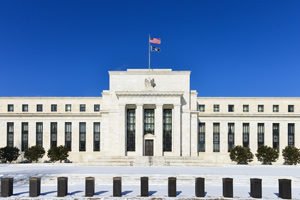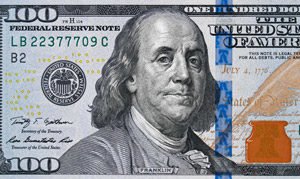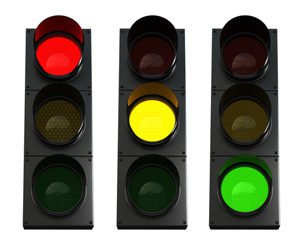I recently showed you why "don't fight the Fed" is likely the most profitable investment advice you can get.
Now I'm going to show you why it works so well.
And while I do that, I'm going to blow the door off the hinges and expose how the Federal Reserve's outsized influence and tight relationships with some of the planet's biggest, most powerful banks can make or break markets...
...and lead you to some of the biggest gains you've ever seen: 100% sure money.
Meet the Fed's "Accomplices"
 Big surprise: The U.S. Federal Reserve does things a little differently than your "usual" bank.
Big surprise: The U.S. Federal Reserve does things a little differently than your "usual" bank.
You see, the Fed handpicks a small group of (very) privileged dealers to trade with.
They are officially called "Primary Dealers," and today there are 23 of them. These banks are based in Canada, France, Switzerland, Japan, Germany, the United Kingdom, and of course, the United States. The foreign banks the Fed deals with maintain a presence in New York City.
The primary dealers have accounts at the Fed, just like you and I have deposit accounts at our bank. When the Fed buys bonds from the dealers, it pays for those bonds by crediting the dealer's account in the amount of the purchase.
This cash is instantly the dealer's to do with as it sees fit. The dealers know what the Fed wants, but it's the dealer's money.
The Fed prints the money. The dealers decide what to do with it - how to deploy it.
The dealers are also known as market makers. Their business involves buying and selling all kinds of securities, not just bonds. They buy at one price with the goal of marking up the cost a bit and selling at a profit.
This is what they've done, day in and day out, for hundreds of years. Most of the time, they're very successful at that business.
They are, in essence, the owners of the markets, just like the big casino companies own Las Vegas.
We are the players at the tables; the customers of the dealers. You and I? We're minnows. Hedge funds and institutions - the big customers - are the whales.
Naturally, the primary dealers use all kinds of psychological tools to manipulate both the small customers like you and me as well as the big whales. The goal is the same: To mark up their securities inventories and sell them to minnow and whale alike at a profit.
When the Fed constantly injects money into this system by buying bonds from the dealers, two things happen:
- The dealers get cash, which they then use to purchase more securities and derivatives; or
- They can leverage the cash to borrow even more money and buy even more securities or derivatives. These include stocks, bonds, commodities, futures, and options.
As you'll see, that is critical to making your own money when the Fed makes a move.
[mmpazkzone name="in-story" network="9794" site="307044" id="137008" type="4"]
Now, stocks are probably their favorite kind of inventory to buy and mark up, because that's where there's the greatest public participation. It's here that the primary dealers have the greatest potential for manipulating both the individual and institutional customers.
Believe it or not, there are even television networks devoted to helping the dealers market and move their inventories to customers. These TV networks are like long-running dealer infomercials. Dealer spokesmen appear with the network hosts to hawk their wares. The spokesmen recommend stocks for the investing public - their customers - to buy. The dealers' trading desks sell the stocks from their own inventories to customers, adding their markup.
The greater the public participation, the more the dealers can mark up their holdings, and the greater the profit for them.
This Deal Is Unbelievable, but It's the Truth
 The Fed stands behind these operations as both the dealers' bank and their biggest customer - a behemoth customer with an endless source of cash. It purchases a known quantity of securities month in and month out, going so far as to tell the dealers exactly how much it wants to buy and over what period.
The Fed stands behind these operations as both the dealers' bank and their biggest customer - a behemoth customer with an endless source of cash. It purchases a known quantity of securities month in and month out, going so far as to tell the dealers exactly how much it wants to buy and over what period.
Get this: The central bank even promised to buy the securities at the market price... whatever it happened to be.
Talk about a no-brainer!
Using quantitative easing, the Fed bought $4 trillion in securities from the dealers. The Fed credited the dealers with that amount of cash into the dealers' accounts. The dealers then used that cash to buy more securities, including, most importantly for our purposes, stocks.
At the same time, the primary dealers are tasked with purchasing U.S. Treasury debt securities from the U.S. government.
The Federal government must constantly borrow hundreds of billions of dollars from the markets to fund its regular outlays. The dealers are required to participate in the auctions of those securities. The dealers then get to trade that inventory with the public, selling and buying bonds and stocks, mostly with a nice markup.
So the Fed has been providing an amount of cash each month that enables the dealers to buy their usual allotment of Treasury debt securities with something left over. As long as the Fed does that, the dealers have the wherewithal to engage in acquiring, marking up, and distributing stocks at a profit to themselves.
Sounds pretty cushy, right? Well, I believe things are changing, and it should get pretty ugly when they do...
The Fed's Set to Shut Off the Money Tap
Lately, the Fed has only been buying a trickle of what it used to buy between 2009 and 2014. Now it only buys enough paper from the dealers to replace a (relative) few mortgage-backed securities that the Fed held but were paid off each month.
It's not a problem yet, but it will be when the Fed decides to stop doing that. And the problem will grow worse - much worse - when the Fed stops rolling over trillions of dollars' worth of the Treasury debt that it owns.
Right now, that's scheduled to begin happening in September 2017 - barely a few weeks from now. Investors can expect the foreshocks of this great unwinding to start hitting at the end of August.
 That's why I'm launching Lee Adler's Sure Money. Investors who get into position ahead of these moves stand to do best, both in terms of protecting their capital and going after aggressive gains. I believe plenty of folks could lose their shirts in the coming weeks and months.
That's why I'm launching Lee Adler's Sure Money. Investors who get into position ahead of these moves stand to do best, both in terms of protecting their capital and going after aggressive gains. I believe plenty of folks could lose their shirts in the coming weeks and months.
The movements of money I just described are in fact the key to Sure Money's "Red Light, Yellow Light, Green Light" system I told you about on Friday: the flow of Fed dollars into, out of, and around the open markets.
Here's how it's going to work:
Red Light: Money is moving out...
Yellow Light: Proceed with caution. Things may be changing.
Green Light: Money is moving back in...
I'll issue recommendations to buy, sell, or hold based on the powerful technical charts I've developed since getting into the markets in the early 1970s. Twice each week, I'll update my Lee Adler's Sure Money readers on what my charts are saying on the flow of liquidity.
I'm going to give everyone the chance to see this in action for themselves. Just click here to get my free updates twice each week. Then you'll get the best recommendations I have for staying ahead of the waves of Fed liquidity washing in and out of the markets.
It'll be easy. Sure money.
Talk to you then.
About the Author
Financial Analyst, 50-year charting expert, finance + real estate pro, and market analyst; published and edited the Wall Street Examiner since 2000.



